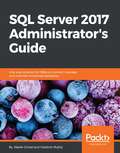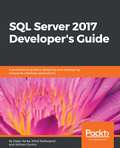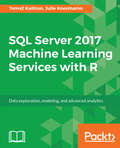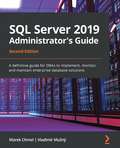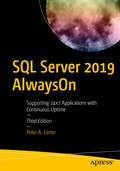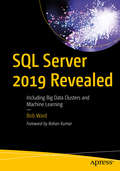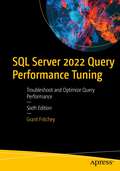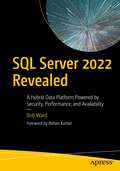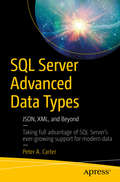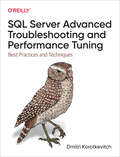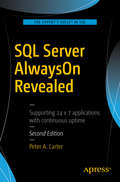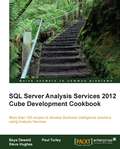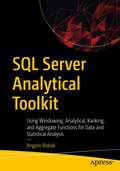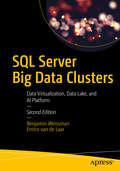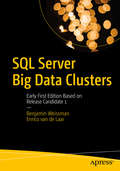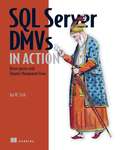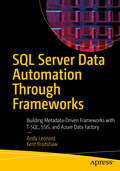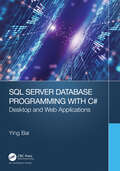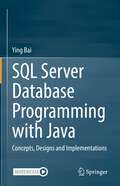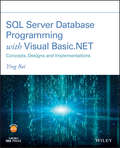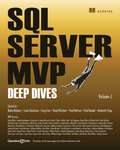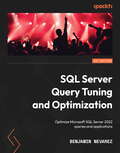- Table View
- List View
SQL Server 2017 Administrator's Guide
by Marek Chmel Vladimir MuznyImplement and administer successful database solution with SQL Server 2017 About This Book • Master the required skills to successfully set up, administer, and maintain your SQL Server 2017 database solution • Design and configure, manage, and secure a rock-solid SQL server • Comprehensive guide in keeping your SQL server disaster proof and all-time availability Who This Book Is For This book targets database administrators with an interest in SQL Server 2017 administration. Readers are expected to have some experience with previous SQL Server versions. What You Will Learn • Learn about the new features of SQL Server 2017 and how to implement them • Build a stable and fast SQL Server environment • Fix performance issues by optimizing queries and making use of indexes • Perform a health check of an existing troublesome database environment • Design and use an optimal database management strategy • Implement efficient backup and recovery techniques in-line with security policies • Combine SQL Server 2017 and Azure and manage your solution by various automation techniques Perform data migration, cluster upgradation and server consolidation In Detail Take advantage of the real power of SQL Server 2017 with all its new features, in addition to covering core database administration tasks. This book will give you a competitive advantage by helping you quickly learn how to design, manage, and secure your database solution. You will learn how to set up your SQL Server and configure new (and existing) environments for optimal use. After covering the designing aspect, the book delves into performance-tuning aspects by teaching you how to effectively use indexes. The book will also teach you about certain choices that need to be made about backups and how to implement a rock-solid security policy and keep your environment healthy. Finally, you will learn about the techniques you should use when things go wrong, and other important topics - such as migration, upgrading, and consolidation - are covered in detail. Integration with Azure is also covered in depth. Whether you are an administrator or thinking about entering the field, this book will provide you with all the skills you need to successfully create, design, and deploy databases using SQL Server 2017. Style and approach A comprehensive guide for database professionals, covering a wide range of topics from installation, maintenance, and configuration to managing systems for operational efficiency and high availability; best practices for maintaining a highly reliable database solution are also supplied from industry experts.
SQL Server 2017 Developer’s Guide: A professional guide to designing and developing enterprise database applications
by Dejan Sarka William Durkin Miloš RadivojevićBuild smarter and efficient database application systems for your organization with SQL Server 2017Key FeaturesBuild database applications by using the development features of SQL Server 2017Work with temporal tables to get information stored in a table at any time Use adaptive querying to enhance the performance of your queriesBook DescriptionMicrosoft SQL Server 2017 is the next big step in the data platform history of Microsoft as it brings in the power of R and Python for machine learning and containerization-based deployment on Windows and Linux. Compared to its predecessor, SQL Server 2017 has evolved into Machine Learning with R services for statistical analysis and Python packages for analytical processing. This book prepares you for more advanced topics by starting with a quick introduction to SQL Server 2017’s new features and a recapitulation of the possibilities you may have already explored with previous versions of SQL Server. The next part introduces you to enhancements in the Transact-SQL language and new database engine capabilities and then switches to a completely new technology inside SQL Server: JSON support. We also take a look at the Stretch database, security enhancements, and temporal tables.Furthermore, the book focuses on implementing advanced topics, including Query Store, columnstore indexes, and In-Memory OLTP. Towards the end of the book, you’ll be introduced to R and how to use the R language with Transact-SQL for data exploration and analysis. You’ll also learn to integrate Python code in SQL Server and graph database implementations along with deployment options on Linux and SQL Server in containers for development and testing. By the end of this book, you will have the required information to design efficient, high-performance database applications without any hassle.What you will learn Explore the new development features introduced in SQL Server 2017 Identify opportunities for In-Memory OLTP technology Use columnstore indexes to get storage and performance improvements Exchange JSON data between applications and SQL Server Use the new security features to encrypt or mask the data Control the access to the data on the row levels Discover the potential of R and Python integration Model complex relationships with the graph databases in SQL Server 2017Who this book is forDatabase developers and solution architects looking to design efficient database applications using SQL Server 2017 will find this book very useful. In addition, this book will be valuable to advanced analysis practitioners and business intelligence developers. Database consultants dealing with performance tuning will get a lot of useful information from this book as well.Some basic understanding of database concepts and T-SQL is required to get the best out of this book.
SQL Server 2017 Machine Learning Services with R: Data exploration, modeling, and advanced analytics
by Julie Koesmarno Tomaz KastrunDevelop and run efficient R scripts and predictive models for SQL Server 2017 Key Features Learn how you can combine the power of R and SQL Server 2017 to build efficient, cost-effective data science solutions Leverage the capabilities of R Services to perform advanced analytics—from data exploration to predictive modeling A quick primer with practical examples to help you get up- and- running with SQL Server 2017 Machine Learning Services with R, as part of database solutions with continuous integration / continuous delivery. Book Description R Services was one of the most anticipated features in SQL Server 2016, improved significantly and rebranded as SQL Server 2017 Machine Learning Services. Prior to SQL Server 2016, many developers and data scientists were already using R to connect to SQL Server in siloed environments that left a lot to be desired, in order to do additional data analysis, superseding SSAS Data Mining or additional CLR programming functions. With R integrated within SQL Server 2017, these developers and data scientists can now benefit from its integrated, effective, efficient, and more streamlined analytics environment. This book gives you foundational knowledge and insights to help you understand SQL Server 2017 Machine Learning Services with R. First and foremost, the book provides practical examples on how to implement, use, and understand SQL Server and R integration in corporate environments, and also provides explanations and underlying motivations. It covers installing Machine Learning Services;maintaining, deploying, and managing code;and monitoring your services. Delving more deeply into predictive modeling and the RevoScaleR package, this book also provides insights into operationalizing code and exploring and visualizing data. To complete the journey, this book covers the new features in SQL Server 2017 and how they are compatible with R, amplifying their combined power. What you will learn Get an overview of SQL Server 2017 Machine Learning Services with R Manage SQL Server Machine Learning Services from installation to configuration and maintenance Handle and operationalize R code Explore RevoScaleR R algorithms and create predictive models Deploy, manage, and monitor database solutions with R Extend R with SQL Server 2017 features Explore the power of R for database administratorsWho this book is for This book is for data analysts, data scientists, and database administrators with some or no experience in R but who are eager to easily deliver practical data science solutions in their day-to-day work (or future projects) using SQL Server.
SQL Server 2019 Administrator's Guide: A definitive guide for DBAs to implement, monitor, and maintain enterprise database solutions, 2nd Edition
by Marek Chmel Vladimír MužnýUse Microsoft SQL Server 2019 to implement, administer, and secure a robust database solution that is disaster-proof and highly available Key Features Explore new features of SQL Server 2019 to set up, administer, and maintain your database solution successfully Develop a dynamic SQL Server environment and streamline big data pipelines Discover best practices for fixing performance issues, database access management, replication, and security Book Description SQL Server is one of the most popular relational database management systems developed by Microsoft. This second edition of the SQL Server Administrator's Guide will not only teach you how to administer an enterprise database, but also help you become proficient at managing and keeping the database available, secure, and stable. You'll start by learning how to set up your SQL Server and configure new and existing environments for optimal use. The book then takes you through designing aspects and delves into performance tuning by showing you how to use indexes effectively. You'll understand certain choices that need to be made about backups, implement security policy, and discover how to keep your environment healthy. Tools available for monitoring and managing a SQL Server database, including automating health reviews, performance checks, and much more, will also be discussed in detail. As you advance, the book covers essential topics such as migration, upgrading, and consolidation, along with the techniques that will help you when things go wrong. Once you've got to grips with integration with Azure and streamlining big data pipelines, you'll learn best practices from industry experts for maintaining a highly reliable database solution. Whether you are an administrator or are looking to get started with database administration, this SQL Server book will help you develop the skills you need to successfully create, design, and deploy database solutions. What you will learn Discover SQL Server 2019's new features and how to implement them Fix performance issues by optimizing queries and making use of indexes Design and use an optimal database management strategy Combine SQL Server 2019 with Azure and manage your solution using various automation techniques Implement efficient backup and recovery techniques in line with security policies Get to grips with migrating, upgrading, and consolidating with SQL Server Set up an AlwaysOn-enabled stable and fast SQL Server 2019 environment Understand how to work with Big Data on SQL Server environments Who this book is for This book is for database administrators, database developers, and anyone who wants to administer large and multiple databases single-handedly using Microsoft's SQL Server 2019. Basic awareness of database concepts and experience with previous SQL Server versions is required.
SQL Server 2019 AlwaysOn: Supporting 24x7 Applications with Continuous Uptime
by Peter A. CarterGet a fast start to using AlwaysOn, the SQL Server solution to high-availability and disaster recovery. This third edition is newly-updated to cover the 2019 editions of both SQL Server and Windows Server and includes strong coverage of implementing AlwaysOn Availability Groups on both Windows and Linux operating systems. The book provides a solid and accurate understanding of how to implement systems requiring consistent and continuous uptime, as well as how to troubleshoot those systems in order to keep them running and reliable. This edition is updated to account for all new major functionality and also includes coverage of implementing atypical configurations, such as clusterless and domain-independent Availability Groups, distributed Availability Groups, and implementing Availability Groups on Azure.The book begins with an introduction to high-availability and disaster recovery concepts such as Recovery Point Objectives (RPOs), Recovery Time Objectives (RTOs), availability levels, and the cost of downtime. You’ll then move into detailed coverage of implementing and configuring the AlwaysOn feature set in order to meet the business objectives set by your organization. Content includes coverage on implementing clusters, building AlwaysOn failover clustered instances, and configuring AlwaysOn Availability Groups.SQL Server 2019 AlwaysOn is chock full of real-world advice on how to build and configure the most appropriate topology to meet the high-availability and disaster recovery requirements you are faced with, as well as how to use AlwaysOn Availability Groups to scale-out read-only workloads. This is a practical and hands-on book to get you started quickly in using one of the most talked-about SQL Server feature sets. What You Will Learn Understand high availability and disaster recovery in SQL Server 2019Build and configure a Windows Cluster in Windows Server 2019Create and configure an AlwaysOn failover clustered instanceImplement AlwaysOn Availability Groups and appropriately configure themImplement AlwaysOn Availability Groups on Linux serversConfigure Availability Groups on Azure IaaSAdminister AlwaysOn technologies post implementationUnderstand typical configurations, such as clusterless and distributed Availability Groups Who This Book Is For For Microsoft SQL Server database administrators who interested in growing their knowledge and skills in SQL Server’s high-availability and disaster recovery feature set.
SQL Server 2019 Revealed: Including Big Data Clusters and Machine Learning
by Bob WardGet up to speed on the game-changing developments in SQL Server 2019. No longer just a database engine, SQL Server 2019 is cutting edge with support for machine learning (ML), big data analytics, Linux, containers, Kubernetes, Java, and data virtualization to Azure. This is not a book on traditional database administration for SQL Server. It focuses on all that is new for one of the most successful modernized data platforms in the industry. It is a book for data professionals who already know the fundamentals of SQL Server and want to up their game by building their skills in some of the hottest new areas in technology.SQL Server 2019 Revealed begins with a look at the project's team goal to integrate the world of big data with SQL Server into a major product release. The book then dives into the details of key new capabilities in SQL Server 2019 using a “learn by example” approach for Intelligent Performance, security, mission-critical availability, and features for the modern developer. Also covered are enhancements to SQL Server 2019 for Linux and gain a comprehensive look at SQL Server using containers and Kubernetes clusters.The book concludes by showing you how to virtualize your data access with Polybase to Oracle, MongoDB, Hadoop, and Azure, allowing you to reduce the need for expensive extract, transform, and load (ETL) applications. You will then learn how to take your knowledge of containers, Kubernetes, and Polybase to build a comprehensive solution called Big Data Clusters, which is a marquee feature of 2019. You will also learn how to gain access to Spark, SQL Server, and HDFS to build intelligence over your own data lake and deploy end-to-end machine learning applications.What You Will LearnImplement Big Data Clusters with SQL Server, Spark, and HDFSCreate a Data Hub with connections to Oracle, Azure, Hadoop, and other sourcesCombine SQL and Spark to build a machine learning platform for AI applicationsBoost your performance with no application changes using Intelligent PerformanceIncrease security of your SQL Server through Secure Enclaves and Data ClassificationMaximize database uptime through online indexing and Accelerated Database RecoveryBuild new modern applications with Graph, ML Services, and T-SQL Extensibility with JavaImprove your ability to deploy SQL Server on LinuxGain in-depth knowledge to run SQL Server with containers and KubernetesKnow all the new database engine features for performance, usability, and diagnosticsUse the latest tools and methods to migrate your database to SQL Server 2019Apply your knowledge of SQL Server 2019 to AzureWho This Book Is ForIT professionals and developers who understand the fundamentals of SQL Server and wish to focus on learning about the new, modern capabilities of SQL Server 2019. The book is for those who want to learn about SQL Server 2019 and the new Big Data Clusters and AI feature set, support for machine learning and Java, how to run SQL Server with containers and Kubernetes, and increased capabilities around Intelligent Performance, advanced security, and high availability.
SQL Server 2022 Query Performance Tuning: Troubleshoot and Optimize Query Performance
by Grant FritcheyTroubleshoot slow-performing queries and make them run faster. Database administrators and SQL developers are constantly under pressure to provide more speed. This new edition has been redesigned and rewritten from scratch based on the last 15 years of learning, knowledge, and experience accumulated by the author. The book Includes expanded information on using extended events, automatic execution plan correction, and other advanced features now available in SQL Server. These modern features are covered while still providing the necessary fundamentals to better understand how statistics and indexes affect query performance.The book gives you knowledge and tools to help you identify poorly performing queries and understand the possible causes of that poor performance. The book also provides mechanisms for resolving the issues identified, whether on-premises, in containers, or on cloud platform providers. You’ll learn about key fundamentals, such as statistics, data distribution, cardinality, and parameter sniffing. You’ll learn to analyze and design your indexes and your queries using best practices that ward off performance problems before they occur. You’ll also learn to use important modern features, such as Query Store to manage and control execution plans, the automated performance tuning feature set, and memory-optimized OLTP tables and procedures. You will be able to troubleshoot in a systematic way. Query tuning doesn’t have to be difficult. This book helps you to make it much easier.What You Will LearnUse Query Store to understand and easily change query performanceRecognize and eliminate bottlenecks leading to slow performanceTune queries whether on-premises, in containers, or on cloud platform providersImplement best practices in T-SQL to minimize performance riskDesign in the performance that you need through careful query and index designUnderstand how built-in, automatic tuning can assist your performance enhancement effortsProtect query performance during upgrades to the newer versions of SQL ServerWho This Book Is ForDevelopers and database administrators with responsibility for query performance in SQL Server environments, and anyone responsible for writing or creating T-SQL queries and in need of insight into bottlenecks (including how to identify them, understand them, and eliminate them)
SQL Server 2022 Revealed: A Hybrid Data Platform Powered by Security, Performance, and Availability
by Bob WardKnow how to use the new capabilities and cloud integrations in SQL Server 2022. This book covers the many innovative integrations with the Azure Cloud that make SQL Server 2022 the most cloud-connected edition ever. The book covers cutting-edge features such as the blockchain-based Ledger for creating a tamper-evident record of changes to data over time that you can rely on to be correct and reliable. You'll learn about built-in Query Intelligence capabilities to help you to upgrade with confidence that your applications will perform at least as fast after the upgrade than before. In fact, you'll probably see an increase in performance from the upgrade, with no code changes needed. Also covered are innovations such as contained availability groups and data virtualization with S3 object storage.New cloud integrations covered in this book include Microsoft Azure Purview and the use of Azure SQL for high availability and disaster recovery. The book covers Azure Synapse Link with its built-in capabilities to take changes and put them into Synapse automatically.Anyone building their career around SQL Server will want this book for the valuable information it provides on building SQL skills from edge to the cloud. What You Will LearnKnow how to use all of the new capabilities and cloud integrations in SQL Server 2022Connect to Azure for disaster recovery, near real-time analytics, and securityLeverage the Ledger to create a tamper-evident record of data changes over timeUpgrade from prior releases and achieve faster and more consistent performance with no code changesAccess data and storage in different and new formats, such as Parquet and S3, without moving the data and using your existing T-SQL skillsExplore new application scenarios using innovations with T-SQL in areas such as JSON and time seriesWho This Book Is ForSQL Server professionals who want to upgrade their skills to the latest edition of SQL Server; those wishing to take advantage of new integrations with Microsoft Azure Purview (governance), Azure Synapse (analytics), and Azure SQL (HA and DR); and those in need of the increased performance and security offered by Query Intelligence and the new Ledger
SQL Server Advanced Data Types: JSON, XML, and Beyond
by Peter A. CarterDeliver advanced functionality faster and cheaper by exploiting SQL Server's ever-growing amount of built-in support for modern data formats. Learn about the growing support within SQL Server for operations and data transformations that have previously required third-party software and all the associated licensing and development costs. Benefit through a better understanding of what can be done inside the database engine with no additional costs or development time invested in outside software.Widely used types such as JSON and XML are well-supported by the database engine. The same is true of hierarchical data and even temporal data. Knowledge of these advanced types is crucial to unleashing the full power that's available from your organization's SQL Server database investment. SQL Server Advanced Data Types explores each of the complex data types supplied within SQL Server. Common usage scenarios for each complex data type are discussed, followed by a detailed discussion on how to work with each data type. Each chapter demystifies the complex data and you learn how to use the data types most efficiently.The book offers a practical guide to working with complex data, using real-world examples to demonstrate how each data type can be leveraged. Performance considerations are also discussed, including the implementation of special indexes such as XML indexes and spatial indexes.What You'll LearnUnderstand the implementation of basic data types and why using the correct type is so importantWork with XML data through the XML data typeConstruct XML data from relational result setsStore and manipulate JSON data using the JSON data typeModel and analyze spatial data for geographic information systemsDefine hierarchies and query them efficiently through the HierarchyID typeWho This Book Is ForSQL Server developers and application developers who need to store and access complex data structures
SQL Server Advanced Troubleshooting and Performance Tuning: Best Practices and Techniques
by Dmitri KorotkevitchThis practical book provides a comprehensive overview of troubleshooting and performance tuning best practices for Microsoft SQL Server. Database engineers, including database developers and administrators, will learn how to identify performance issues, troubleshoot the system in a holistic fashion, and properly prioritize tuning efforts to attain the best system performance possible.Author Dmitri Korotkevitch, Microsoft Data Platform MVP and Microsoft Certified Master (MCM), explains the interdependencies between SQL Server database components. You'll learn how to quickly diagnose your system and discover the root cause of any issue. Techniques in this book are compatible with all versions of SQL Server and cover both on-premises and cloud-based SQL Server installations.Discover how performance issues present themselves in SQL ServerLearn about SQL Server diagnostic tools, methods, and technologiesPerform health checks on SQL Server installationsLearn the dependencies between SQL Server componentsTune SQL Server to improve performance and reduce bottlenecksDetect poorly optimized queries and inefficiencies in query execution plansFind inefficient indexes and common database design issuesUse these techniques with Microsoft Azure SQL databases, Azure SQL Managed Instances, and Amazon RDS for SQL Server
SQL Server AlwaysOn Revealed
by Peter A. CarterGet a fast start to using AlwaysOn, the SQL Server solution to high-availability and disaster recovery. This second edition is newly-updated to cover the 2016 editions of both SQL Server and Windows Server. Also in this edition is all-new content on troubleshooting and metadata. The book provides a solid and accurate understanding of how to implement systems requiring consistent and continuous uptime, as well as how to troubleshoot those systems in order to keep them running an reliable. Begin with an introduction to high-availability and disaster recovery concepts such as Recovery Point Objectives (RPOs), Recovery Time Objectives (RTO), availability levels, and the cost of downtime. Then move into detailed coverage of implementing and configuring the AlwaysOn feature set in order to meet the business objectives set by your organization. SQL Server AlwaysOn Revealed offers real-world advice on how to build and configure the most appropriate topology to meet the high-availability and disaster recovery requirements you are faced with. Content includes strong coverage on implementing clusters, on building AlwaysOn failover clustered instances, and on configuring AlwaysOn Availability Groups. This is a practical and hand-on book to get you started quickly in using one of the most talked-about SQL Server feature sets. Teaches you to build HA and DR solutions using the AlwaysOn feature set Provides real-world advice on configuration and performance considerations Demonstrates administrative techniques for the AlwaysOn feature set What You Will Learn Understand high availability and disaster recovery in SQL Server 2016 Build and configure a Windows Cluster Create and configure an AlwaysOn failover clustered instance Implement AlwaysOn Availability Groups and appropriately configure them Administer AlwaysOn technologies post implementation Troubleshoot and resolve problems with misbehaving systems Who This Book Is For Database administrators interested in growing their knowledge and skills in Microsoft SQL Server's high-availability and disaster recovery feature set.
SQL Server Analysis Services 2012 Cube Development Cookbook
by Paul Turley Steve Hughes Baya DewaldA practical cookbook packed with recipes to help developers produce data cubes as quickly as possible by following step by step instructions, rather than explaining data mining concepts with SSAS.If you are a BI or ETL developer using SQL Server Analysis services to build OLAP cubes, this book is ideal for you. Prior knowledge of relational databases and experience with Excel as well as SQL development is required.
SQL Server Analytical Toolkit: Using Windowing, Analytical, Ranking, and Aggregate Functions for Data and Statistical Analysis
by Angelo BobakLearn window function foundational concepts through a cookbook-style approach, beginning with an introduction to the OVER() clause, its various configurations in terms of how partitions and window frames are created, and how data is sorted in the partition so that the window function can operate on the partition data sets. You will build a toolkit based not only on the window functions but also on the performance tuning tools, use of Microsoft Excel to graph results, and future tools you can learn such as PowerBI, SSIS, and SSAS to enhance your data architecture skills.This book goes beyond just showing how each function works. It presents four unique use-case scenarios (sales, financial, engineering, and inventory control) related to statistical analysis, data analysis, and BI. Each section is covered in three chapters, one chapter for each of the window aggregate, ranking, and analytical function categories.Each chapter includes several TSQL code examples and is re-enforced with graphic output plus Microsoft Excel graphs created from the query output. SQL Server estimated query plans are generated and described so you can see how SQL Server processes the query. These together with IO, TIME, and PROFILE statistics are used to performance tune the query. You will know how to use indexes and when not to use indexes.You will learn how to use techniques such as creating report tables, memory enhanced tables, and creating clustered indexes to enhance performance. And you will wrap up your learning with suggested steps related to business intelligence and its relevance to other Microsoft Tools such as Power BI and Analysis Services.All code examples, including code to create and load each of the databases, are available online.What You Will LearnUse SQL Server window functions in the context of statistical and data analysisRe-purpose code so it can be modified for your unique applicationsStudy use-case scenarios that span four critical industriesGet started with statistical data analysis and data mining using TSQL queries to dive deep into dataStudy discussions on statistics, how to use SSMS, SSAS, performance tuning, and TSQL queries using the OVER() clause.Follow prescriptive guidance on good coding standards to improve code legibility Who This Book Is ForIntermediate to advanced SQL Server developers and data architects. Technical and savvy business analysts who need to apply sophisticated data analysis for their business users and clients will also benefit. This book offers critical tools and analysis techniques they can apply to their daily job in the disciplines of data mining, data engineering, and business intelligence.
SQL Server Big Data Clusters: Data Virtualization, Data Lake, and AI Platform
by Benjamin Weissman Enrico van de LaarUse this guide to one of SQL Server 2019’s most impactful features—Big Data Clusters. You will learn about data virtualization and data lakes for this complete artificial intelligence (AI) and machine learning (ML) platform within the SQL Server database engine. You will know how to use Big Data Clusters to combine large volumes of streaming data for analysis along with data stored in a traditional database. For example, you can stream large volumes of data from Apache Spark in real time while executing Transact-SQL queries to bring in relevant additional data from your corporate, SQL Server database. Filled with clear examples and use cases, this book provides everything necessary to get started working with Big Data Clusters in SQL Server 2019. You will learn about the architectural foundations that are made up from Kubernetes, Spark, HDFS, and SQL Server on Linux. You then are shown how to configure and deploy Big Data Clusters in on-premises environments or in the cloud. Next, you are taught about querying. You will learn to write queries in Transact-SQL—taking advantage of skills you have honed for years—and with those queries you will be able to examine and analyze data from a wide variety of sources such as Apache Spark. Through the theoretical foundation provided in this book and easy-to-follow example scripts and notebooks, you will be ready to use and unveil the full potential of SQL Server 2019: combining different types of data spread across widely disparate sources into a single view that is useful for business intelligence and machine learning analysis. What You Will LearnInstall, manage, and troubleshoot Big Data Clusters in cloud or on-premise environmentsAnalyze large volumes of data directly from SQL Server and/or Apache SparkManage data stored in HDFS from SQL Server as if it were relational dataImplement advanced analytics solutions through machine learning and AIExpose different data sources as a single logical source using data virtualizationWho This Book Is ForData engineers, data scientists, data architects, and database administrators who want to employ data virtualization and big data analytics in their environments
SQL Server Big Data Clusters: Early First Edition Based on Release Candidate 1
by Benjamin Weissman Enrico van de LaarGet a head-start on learning one of SQL Server 2019’s latest and most impactful features—Big Data Clusters—that combines large volumes of non-relational data for analysis along with data stored relationally inside a SQL Server database. This book provides a first look at Big Data Clusters based upon SQL Server 2019 Release Candidate 1. Start now and get a jump on your competition in learning this important new feature. Big Data Clusters is a feature set covering data virtualization, distributed computing, and relational databases and provides a complete AI platform across the entire cluster environment. This book shows you how to deploy, manage, and use Big Data Clusters. For example, you will learn how to combine data stored on the HDFS file system together with data stored inside the SQL Server instances that make up the Big Data Cluster. Filled with clear examples and use cases, this book provides everything necessary to get started working with Big Data Clusters in SQL Server 2019 using Release Candidate 1. You will learn about the architectural foundations that are made up from Kubernetes, Spark, HDFS, and SQL Server on Linux. You then are shown how to configure and deploy Big Data Clusters in on-premises environments or in the cloud. Next, you are taught about querying. You will learn to write queries in Transact-SQL—taking advantage of skills you have honed for years—and with those queries you will be able to examine and analyze data from a wide variety of sources such as Apache Spark. Through the theoretical foundation provided in this book and easy-to-follow example scripts and notebooks, you will be ready to use and unveil the full potential of SQL Server 2019: combining different types of data spread across widely disparate sources into a single view that is useful for business intelligence and machine learning analysis. What You Will LearnInstall, manage, and troubleshoot Big Data Clusters in cloud or on-premise environmentsAnalyze large volumes of data directly from SQL Server and/or Apache SparkManage data stored in HDFS from SQL Server as if it were relational dataImplement advanced analytics solutions through machine learning and AIExpose different data sources as a single logical source using data virtualizationWho This Book Is ForFor data engineers, data scientists, data architects, and database administrators who want to employ data virtualization and big data analytics in their environment
SQL Server DMVs in Action: Better Queries with Dynamic Management Views
by Ian StirkEvery action in SQL Server - queries, updates, whatever - leaves a set of tiny footprints; SQL Server records all that valuable data and makes it visible through Dynamic Management Views, or DMVs. A DBA or developer can use this incredibly detailed information to significantly improve the performance of queries and better understand what's really going on inside a SQL Server systemSQL Server DMVs in Action is a practical guide that shows how to obtain, interpret, and act on the information captured by DMVs to keep SQL Server in top shape. The 100+ samples provided in this book will help readers master DMVs and also give them a tested, working, and instantly reusable SQL code library. Purchase of the print book comes with an offer of a free PDF, ePub, and Kindle eBook from Manning. Also available is all code from the book.
SQL Server Data Automation Through Frameworks: Building Metadata-Driven Frameworks with T-SQL, SSIS, and Azure Data Factory
by Andy Leonard Kent BradshawLearn to automate SQL Server operations using frameworks built from metadata-driven stored procedures and SQL Server Integration Services (SSIS). Bring all the power of Transact-SQL (T-SQL) and Microsoft .NET to bear on your repetitive data, data integration, and ETL processes. Do this for no added cost over what you’ve already spent on licensing SQL Server. The tools and methods from this book may be applied to on-premises and Azure SQL Server instances. The SSIS framework from this book works in Azure Data Factory (ADF) and provides DevOps personnel the ability to execute child packages outside a project—functionality not natively available in SSIS.Frameworks not only reduce the time required to deliver enterprise functionality, but can also accelerate troubleshooting and problem resolution. You'll learn in this book how frameworks also improve code quality by using metadata to drive processes. Much of the work performed by data professionals can be classified as “drudge work”—tasks that are repetitive and template-based. The frameworks-based approach shown in this book helps you to avoid that drudgery by turning repetitive tasks into "one and done" operations. Frameworks as described in this book also support enterprise DevOps with built-in logging functionality.What You Will LearnCreate a stored procedure framework to automate SQL process executionBase your framework on a working system of stored procedures and execution loggingCreate an SSIS framework to reduce the complexity of executing multiple SSIS packagesDeploy stored procedure and SSIS frameworks to Azure Data Factory environments in the cloudWho This Book Is ForDatabase administrators and developers who are involved in enterprise data projects built around stored procedures and SQL Server Integration Services (SSIS). Readers should have a background in programming along with a desire to optimize their data efforts by implementing repeatable processes that support enterprise DevOps.
SQL Server Database Programming with C#: Desktop and Web Applications
by Ying BaiDatabases have become an integral part of modern-day life. We live in an information-driven society and database technology has a direct impact on our daily lives. Decisions are routinely made by organizations based on the information collected and stored in the databases. Because databases play such an important role in business and society, database programming is a key skill. SQL Server Database Programming with C#: Desktop and Web Applications is for college students and software programmers who want to develop practical and commercial skills in database programming with C# or Visual C#.NET 2022 as well as the relational database Microsoft SQL Server 2019. The book explains the practical considerations and applications in database programming with Visual C# 2022 and provides realistic examples and detailed explanations. A direct writing style is combined with real-world examples to provide readers with a clear picture of how to handle database programming issues in the Visual C#.NET 2022 environment. Highlights include: A complete sample database CSE_DEPT, built with Microsoft SQL Server 2019 Express, is provided and used for the entire book. Step-by-step, detailed illustrations and descriptions show how to design and build a practical relational database. Both fundamental and advanced database-programming techniques are covered to benefit beginning students and experienced programmers. An advanced database query technique, LINQ API, which includes LINQ to Objects, LINQ to DataSet, LINQ to SQL, LINQ to Entities and LINQ to XML, is discussed, analyzed, and implemented in actual projects with line-by-line explanations. Homework and class projects are provided for each chapter to strengthen and improve students’ abilities to learn and understand the topics they studied. PowerPoint teaching slides and selected homework solutions help instructors to teach and organize their classes easily and effectively. Useful and practical, this textbook is an intuitive guide on how to develop and build professional and practical database applications.
SQL Server Database Programming with Java: Concepts, Designs and Implementations
by Ying BaiThis textbook covers both fundamental and advanced Java database programming techniques for beginning and experienced students as well as programmers (courses related to database programming in Java with Apache NetBeans IDE 12 environment). A sample SQL Server 2019 Express database, CSE_DEPT, is created and implemented in all example projects throughout this textbook. Over 40 real sample database programming projects are covered in this textbook with detailed illustrations and explanations to help students understand the key techniques and programming technologies. Chapters include homework and selected solutions to strengthen and improve students’ learning and understanding for topics they study in the classroom. Both Java desktop and Web applications with SQL Server database programming techniques are discussed and analyzed. Some updated Java techniques, such as Java Server Pages (JSP), Java Server Faces (JSF), Java Web Service (JWS), JavaServer Pages Standard Tag Library (JSTL), JavaBeans and Java API for XML Web Services (JAX-WS) are also discussed and implemented in the real projects developed in this textbook.This textbook targets mainly advanced-level students in computer science, but it also targets entry-level students in computer science and information system. Programmers, software engineers and researchers will also find this textbook useful as a reference for their projects.
SQL Server Database Programming with Visual Basic.NET: Concepts, Designs and Implementations
by Ying BaiA guide to the practical issues and applications in database programming with updated Visual Basic.NET SQL Server Database Programming with Visual Basic.NET offers a guide to the fundamental knowledge and practical techniques for the design and creation of professional database programs that can be used for real-world commercial and industrial applications. The author—a noted expert on the topic—uses the most current version of Visual Basic.NET, Visual Basic.NET 2017 with Visual Studio.NET 2017. In addition, he introduces the updated SQL Server database and Microsoft SQL Server 2017 Express. All sample program projects can be run in the most updated version, Visual Basic.NET 2019 with Visual Studio.NET 2019. Written in an accessible, down-to-earth style, the author explains how to build a sample database using the SQL Server management system and Microsoft SQL Server Management Studio 2018. The latest version of ASP.NET, ASP.NET 4.7, is also discussed to provide the most up-to-date Web database programming technologies. This important book: • Offers illustrative practical examples and detailed descriptions to aid in comprehension of the material presented • Includes both fundamental and advanced database programming techniques • Integrates images into associated database tables using a DevExpress UI tools - WindowsUI Written for graduate and senior undergraduate students studying database implementations and programming courses, SQL Server Database Programming with Visual Basic.NET shows how to develop professional and practical database programs in Visual Basic.NET 2017/Visual Basic.NET 2019.
SQL Server Integration Services Design Patterns
by Andy Leonard Matt Masson Tim Mitchell Jessica Moss Michelle UffordSQL Server Integration Services Design Patterns is newly-revised for SQL Server 2014, and is a book of recipes for SQL Server Integration Services (SSIS). Design patterns in the book help to solve common problems encountered when developing data integration solutions. The patterns and solution examples in the book increase your efficiency as an SSIS developer, because you do not have to design and code from scratch with each new problem you face. The book's team of expert authors take you through numerous design patterns that you'll soon be using every day, providing the thought process and technical details needed to support their solutions. SQL Server Integration Services Design Patterns goes beyond the surface of the immediate problems to be solved, delving into why particular problems should be solved in certain ways. You'll learn more about SSIS as a result, and you'll learn by practical example. Where appropriate, the book provides examples of alternative patterns and discusses when and where they should be used. Highlights of the book include sections on ETL Instrumentation, SSIS Frameworks, Business Intelligence Markup Language, and Dependency Services. Takes you through solutions to common data integration challengesProvides examples involving Business Intelligence Markup LanguageTeaches SSIS using practical examples
SQL Server MVP Deep Dives
by Paul S. Randal Adam Machanic Kimberly Tripp Paul NielsenThis is not an ordinary SQL Server Book. SQL Server MVP Deep Dives brings together the world's most highly-regarded SQL Server experts to create a masterful collection of tips, techniques, and experience-driven best practices for SQL Server development and administration. These SQL Server MVPs-53 in all-each selected a topic of great interest to them, and in this unique book, they share their knowledge and passion with you.SQL Server MVP Deep Dives is organized into five parts: Design and Architecture, Development, Administration, Performance Tuning and Optimization, and Business Intelligence. Within each part, you'll find a collection of brilliantly concise and focused chapters that take on key topics like mobile data strategies, Dynamic Management Views, or query performance. The range of subjects covered is comprehensive, from database design tips to data profiling strategies for BI.Additionally, the authors of this book have generously donated 100% of their royalties to support War Child International. War Child International is a network of independent organizations, working across the world to help children affected by war. War Child was founded upon a fundamental goal: to advance the cause of peace through investing hope in the lives of children caught up in the horrors of war. War Child works in many different conflict areas around the world, helping hundreds of thousands of children every year. Visit www.warchild.org for more information. Purchase of the print book comes with an offer of a free PDF, ePub, and Kindle eBook from Manning. Also available is all code from the book.
SQL Server MVP Deep Dives, Volume 2
by Kalen Delaney Paul S. Randal Kimberly Tripp Paul NielsenSummary SQL Server MVP Deep Dives, Volume 2 is a unique book that lets you learn from the best in the business - 64 SQL Server MVPs offer completely new content in this second volume on topics ranging from testing and policy management to integration services, reporting, and performance optimization techniques...and more. About this Book To become an MVP requires deep knowledge and impressive skill. Together, the 64 MVPs who wrote this book bring about 1,000 years of experience in SQL Server administration, development, training, and design. This incredible book captures their expertise and passion in 60 concise, hand-picked chapters and offers valuable insights for readers of all levels. SQL Server MVP Deep Dives, Volume 2 picks up where the first volume leaves off, with completely new content on topics ranging from testing and policy management to integration services, reporting, and performance optimization. The chapters fall into five parts: Architecture and Design, Database Administration, Database Development, Performance Tuning and Optimization, and Business Intelligence. Purchase of the print book comes with an offer of a free PDF, ePub, and Kindle eBook from Manning. Also available is all code from the book. What's Inside Discovering servers with PowerShell Using regular expressions in SSMS Tuning the Transaction Log for OLTP Optimizing SSIS for dimensional data Real-time BI and much more Manning Publications and the authors of this book support the children of Operation Smile, an international children's medical charity that performs free reconstructive surgery for children suffering from facial deformities such as cleft lips and cleft palates by mobilizing medical volunteers who provide education and training programs to local doctors on the latest surgical techniques. =============================================== Table of Contents PART 1 ARCHITECTURE Edited by Louis Davidson PART 2 DATABASE ADMINISTRATION Edited by Paul Randal and Kimberly Tripp PART 3 DATABASE DEVELOPMENT Edited by Paul Nielsen PART 4 PERFORMANCE TUNING AND OPTIMIZATION Edited by Brad M. McGehee PART 5 BUSINESS INTELLIGENCE Edited by Greg Low
SQL Server Query Performance Tuning
by Grant FritcheyQueries not running fast enough? Wondering about the in-memory database features in 2014? Tired of phone calls from frustrated users? Grant Fritchey's book SQL Server Query Performance Tuning is the answer to your SQL Server query performance problems. The book is revised to cover the very latest in performance optimization features and techniques, especially including the newly-added, in-memory database features formerly known under the code name Project Hekaton. This book provides the tools you need to approach your queries with performance in mind. SQL Server Query Performance Tuning leads you through understanding the causes of poor performance, how to identify them, and how to fix them. You'll learn to be proactive in establishing performance baselines using tools like Performance Monitor and Extended Events. You'll learn to recognize bottlenecks and defuse them before the phone rings. You'll learn some quick solutions too, but emphasis is on designing for performance and getting it right, and upon heading off trouble before it occurs. Delight your users. Silence that ringing phone. Put the principles and lessons from SQL Server Query Performance Tuning into practice today. Covers the in-memory features from Project HekatonHelps establish performance baselines and monitor against themGuides in troubleshooting and eliminating of bottlenecks that frustrate users
SQL Server Query Tuning and Optimization: Optimize Microsoft SQL Server 2022 queries and applications
by Benjamin NevarezGet well-versed with ready-to-use techniques for creating high-performance queries and applicationsKey FeaturesSpeed up queries and dramatically improve application performance by both understanding query engine internals and practical query optimizationUnderstand how the query optimizer worksLearn about intelligent query processing and what is new in SQL Server 2022Book DescriptionSQL Server is a relational database management system developed by Microsoft. As a database server, it is a software product with the primary function of storing and retrieving data as requested by other software applications. This book starts by describing the inner workings of the query optimizer, and will enable you to use this knowledge to write better queries and provide the query engine with all the information it needs to produce efficient execution plans. As you progress, you'll get practical query optimization tips for troubleshooting underperforming queries. The book will also guide you through intelligent query processing and what is new in SQL Server 2022. Query performance topics such as the Query Store, In-Memory OLTP and columnstore indexes are covered as well. By the end of this book, you'll be able to get the best possible performance for your queries and applications.What you will learnTroubleshoot queries using methods including extended events, SQL Trace, and dynamic management viewsUnderstand how the execution engine and query operators workSpeed up queries and improve app performance by creating the right indexesDetect and fix cardinality estimation errors by examining query optimizer statisticsMonitor and promote both plan caching and plan reuse to improve app performanceTroubleshoot and improve query performance by using the Query StoreImprove the performance of data warehouse queries by using columnstore indexesHandle query processor limitations with hints and other methodsWho this book is forThis book is for SQL Server developers who are struggling with slow query execution, database administrators who are tasked with troubleshooting slow application performance, and database architects who design SQL Server databases in support of line-of-business and data warehousing applications.
